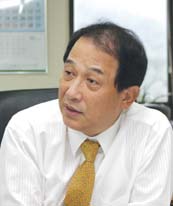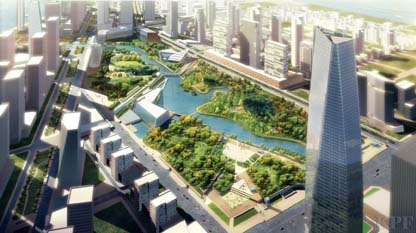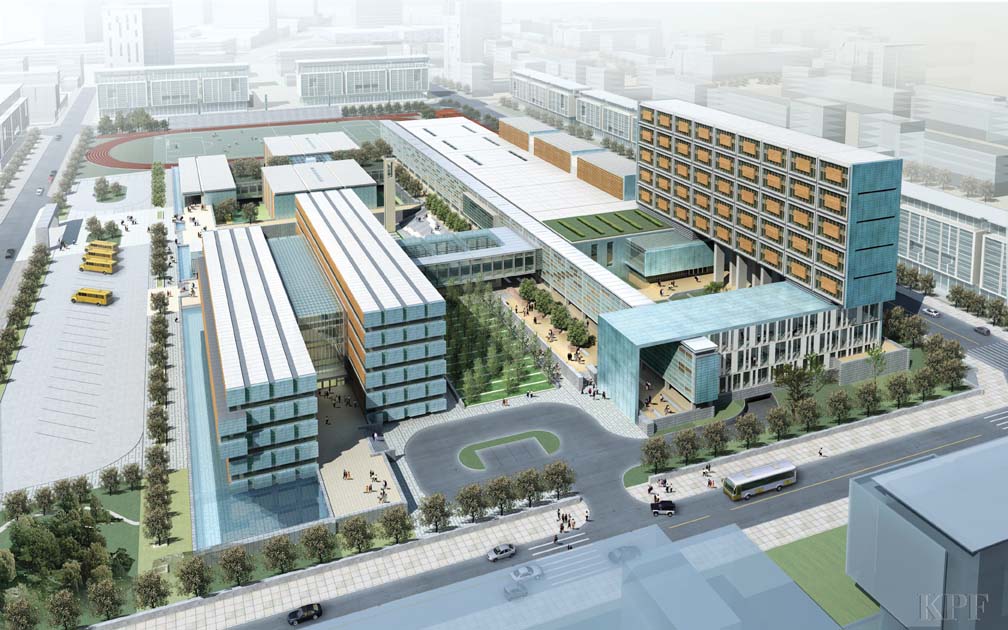Bright Future for FEZs
Deputy Minister Kwon Tae-kyun optimistic on FEZ future and sees more FEZs to come
 Deputy Minister Kwon Tae-kyun in charge of the Planning Office of the Free Economic Zone in the Ministry of Finance and Economy said he is very optimistic about the future of the three existing Free Economic Zones aimed at attracting foreign investment. In an exclusive interview with NewsWorld, the top planner for the FEZs in Korea said they have focused on building the infrastructure so far, and in the next couple of years Songdo International School, 65 story North East Asia Trade Tower will open in Songdo, Incheon along with the Central Park and the Convention Center. In addition, the landmark Incheon Bridge construction is near completion and will help the Zone's effort to attract foreign investment a great deal. The government plans to attract such non-profit organizations as universities and research institutes to lure foreign capital, especially the leading multinationals to set up their operations in the FEZs to springboard into the Chinese market.
Deputy Minister Kwon Tae-kyun in charge of the Planning Office of the Free Economic Zone in the Ministry of Finance and Economy said he is very optimistic about the future of the three existing Free Economic Zones aimed at attracting foreign investment. In an exclusive interview with NewsWorld, the top planner for the FEZs in Korea said they have focused on building the infrastructure so far, and in the next couple of years Songdo International School, 65 story North East Asia Trade Tower will open in Songdo, Incheon along with the Central Park and the Convention Center. In addition, the landmark Incheon Bridge construction is near completion and will help the Zone's effort to attract foreign investment a great deal. The government plans to attract such non-profit organizations as universities and research institutes to lure foreign capital, especially the leading multinationals to set up their operations in the FEZs to springboard into the Chinese market.
 He said two or three localities might win additional FEZ designation in the near future to take advantage of Korea's geo-economic endowment of being right in the middle of vibrant Northeast Asia.
He said two or three localities might win additional FEZ designation in the near future to take advantage of Korea's geo-economic endowment of being right in the middle of vibrant Northeast Asia.
Following are excerpts from the interview:
Question: It has been seven months since you took over the Planning Office of the Free Economic Zone in the Ministry of Finance and Economy. How do you assess the current situation in our FEZs?
Answer: I am very optimistic. Our FEZs cannot be compared to the likes of Pudong, Shenzhen, or Dubai that were set up some twenty years ago by the government. Work on ours began only four years ago. We have to push for our plans steadily. When the visibility shows, foreign investors will hop on the bandwagon. For that, the landmark Incheon Bridge should be completed on schedule in 2009 along with the Central Park, Songdo International School, the Songdo International Hospital, the Convention Center, Asia Trade Tower, POSCO Building, and Jack Niclaus Golf Course among others. And they will.
 Q: For successful inducement of foreign investment, shouldn't the FEZ guarantee economic freedom in the zone and deregulate in the manner of other successful foreign rivals?
Q: For successful inducement of foreign investment, shouldn't the FEZ guarantee economic freedom in the zone and deregulate in the manner of other successful foreign rivals?
A: Results look good. Admittedly, much of the initial 2003 ambition to create regulation-free zones is yet to be achieved. But flat comparison with other special zones is meaningless because circumstances differ from country to country. In fact, ours are not as bad as others, and we continue to shape up ours to meet or beat competition.
Q: What then is the task facing the FEZ authorities?
A: We should rally the public support for the Free Economic Zone. We should have the people understand that the Free Economic Zone and its foreign investment inducement would run the next growth engine for our economy. With the support of the people and policy, we can beat our rivals in China, Dubai, Singapore, or any where.
Q: Many people agree that foreign investment is necessary, and yet some say something else when foreign investors prove successful.
 Don't they have the right to make money for taking the risk and investing?
Don't they have the right to make money for taking the risk and investing?
A: Yes, they do. And we make sure they do.
Q: The Gale International and POSCO Construction appear to have played a significant role in the progress of the IFEZ so far.
A: They joined the forces from the very beginning and took risks even when the reclamation work did not start in Songdo. They deserve the credit. A little sluggish at the inception maybe, but progress nonetheless. Their joint venture NSIC in 7:3 ownership between the Gale and POSCO Construction is developing 5.6 million square meters out of the total 50 million square meters of reclaimed land in Songdo.
Q: What is the amount of total foreign direct investment in the FEZ so far?
A: It tallies to $23 billion as of the end of July.
Q: The Incheon Free Economic Zone Authority is the first of its kind in the country and has shown visible results. Have you been to the site since you took office?
A: I visited the construction site of the Incheon Bridge in July when it was about half way through the completion. The 21.27 kilometer long stretch of this beautiful bridge over the sea will connect the Incheon International Airport to Songdo, making it the sixth longest bridge in the world. I looked at the bridge from the roof of POSCO building and shared with all our MOFE colleagues there the brimming sense of confidence that the FEZ will be a great success and make history.
Q: What about the Gwangyang Free Economic Zone which has been busy attracting foreign investment?
A: Part of the GFEZ strategy was to win transfer cargo shipment to and from China. But the progress so far has been short of expectations, and now we are pushing for its independent expansion. A big theme in GFEZ is the breathtaking beauty of its pristine sea and archipelago around the ultra-modern Gwangyang Port. We have the ambitious plan turn it into the maritime tourism hub with all the luxuries of the finest. We have done extensive environmental assessment and have passed all necessary procedures. Now we are ready to take on and rapidly develop, following the expected victory of Yeosu City in winning the 2012 International Expo. The decision comes in November. The three local autonomies of Yeosu, Gwangyang, and Suncheon have announced their intention to incorporate themselves into one giant municipality. That will be a major boost to the regional economy and GFEZ, especially with the prospect of Yeosu Expo.
Q: Can you tell us about other pertinent issues in managing the Free Economic Zones?
A: We are thinking of designating two or three additional FEZs. In August, the Free Economic Zone Committee convened and announced the plan. Interested local autonomies are expected to submit applications.
No doubt, the work on the three existing Zones are very important. Some may worry about distraction from the existing commitments after the new designation. But first you should take comfort in knowing that the government stands firm on its commitment to the existing ones. Second, the gradual proliferation of the Free Economic Zones is in the direction of making the entire country a good place to do business. Third, we will lead the new FEZs to manage themselves in the transparent way and build on their economic merits, different from those of the existing ones. Fourth, we can learn from the multiple simultaneous launching of the Chinese special zones that proved to be a major thrust in their rapid development. Fifth, infrastructure building would take three to four years for the new Zones, and we would have to start the work as soon as possible. When the applications are received in October, the evaluation committee will give fair and just examination and make transparent selection. nw
The Incheon Free Economic Zone is developed as a business center of Northeast Asia.
Deputy Minister Kwon Tae-kyun for the Planning Office of the Free Economic Zones of the Ministry of Finance and Economy.
An artist's conception shows the Central Park, surrounded by skyscrapers.
The Songdo International School that will open soon.
3Fl, 292-47, Shindang 6-dong, Chung-gu, Seoul, Korea 100-456
Tel : 82-2-2235-6114 / Fax : 82-2-2235-0799